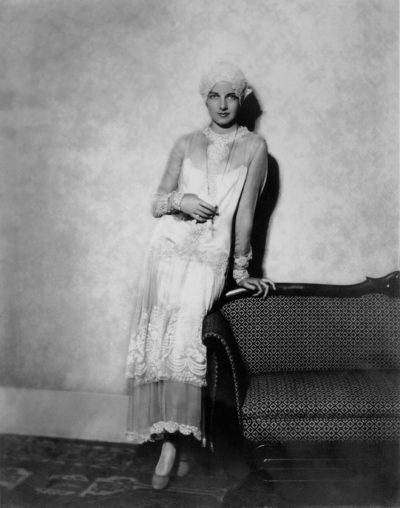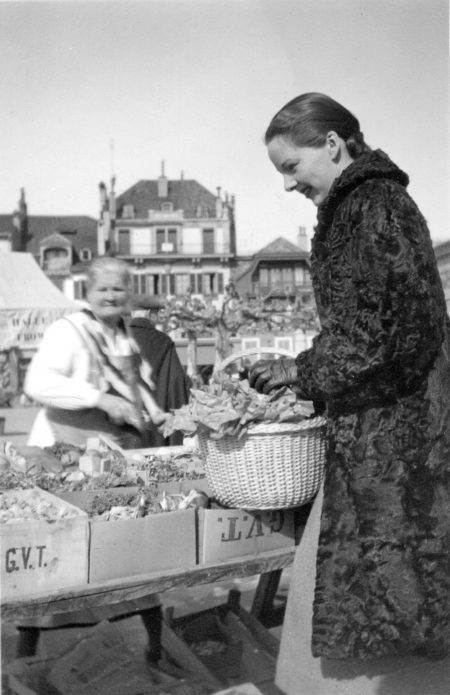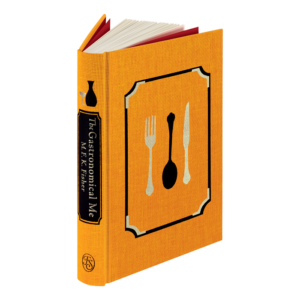
Ruth Reichl on M.F.K. Fisher's Lifetime of Joyous Eating
"To Mary Frances food was a metaphor for living."
“Please don’t whisper,” whispers Mary Frances. Even reduced to the tiniest thread, her voice is imperious.
The small house in the tawny Sonoma fields is quiet. She lies propped up in a large bed in a dark room. Occasionally a beeper issues a peremptory honk, but mostly the sounds are the soft whoosh of the rural highway in front and the quiet murmur of the television in the nurse’s bedroom next door.
We both know this will be the last interview. It is 1992 and she is dying, her wasted body unable to rise from the bed, sunglasses hiding old eyes grown too weak to read. Her voice is so frail a sliver of sound that visitors are forced to bend over, an ear to her mouth, to make out the halting words. Conversation has become so exhausting that after a quarter-hour Mary Frances waves me out of her bedroom.
I stroll into the light airy space that serves as kitchen, living, and dining room. Unframed paintings by Mary Frances’s second husband, Dillwyn Parrish, hang on the walls, a constant reminder of the great love of her life. Piles of books, rivers of books, are everywhere. A biography of Isabella d’Este, Little Women, Mrs Bridge . . . Strewn casually across a table are postcards from friends, and I recognize my own handwriting.
In the late 1970s, when Ms Magazine asked me to profile Mary Frances, I was too intimidated to use the phone; instead, I sent a postcard. “Come see my house!” she wrote back. “It would not be ‘an imposition.'” She enclosed her unlisted phone number, but I never used it; over the next 15 years we made all our plans by mail.
It is, I think, impossible for people raised in our food-obsessed culture to understand the contempt Americans had for food and cooking when I was growing up.
“Do you know who M. F. K. Fisher is?” the editor had asked. I almost dropped the phone, and then began reciting entire passages from memory. “‘There is a communion of more than our bodies when bread is broken and wine drunk,'” I intoned, struggling to explain what M. F. K. Fisher had meant to me.
It is, I think, impossible for people raised in our food-obsessed culture to understand the contempt Americans had for food and cooking when I was growing up. Newspapers of the 1950s banished food to the “women’s pages,” offering pleasant little recipes for ham cooked in Coca-Cola and tips for cleaning your kitchen. People who considered themselves gourmets were mostly men and rarely cooks; they reserved that word for people they employed. Restaurant chefs had even less cachet; uneducated blue-collar workers, they toiled in terrible conditions, rarely venturing out of their miserable kitchens. A suggestion that they would one day be celebrities would have been met with raucous laughter.
My parents, who believed that no serious person had any interest in food, were puzzled by their strange child who inexplicably loved to cook and was fascinated by food. Until I discovered M. F. K. Fisher, it was a lonely existence.
I was nine when I found How to Cook a Wolf hidden among my parents’ books. What it was doing there I will never know; my parents did not own a single cookbook. I imagine it was sent by a friend as some sort of joke. Curious, I opened the book and found this sentence. “Since we must eat to live, we might as well do it with both grace and gusto.” I knew that I had found a kindred spirit.
I peered at the author’s name, wondering about the person who had written this. It told me nothing. Was this M.F.K. male or female?

Fisher used initials deliberately; it was not easy for a woman writing about food to be taken seriously. Raised in a California newspaper family, she was, first, foremost, and very fiercely, a writer. In the 1930s, when she sent her first book, Serve It Forth, off into the world, she thought it would have a better chance if people assumed that the author was a man.
I went to the library, borrowed the book, and stayed up all night reading it under the covers with a flashlight. One chapter began, “Almost every person has something secret he likes to eat,” and my heart thumped as I read Mary Frances’s voluptuous description of her private relationship with tangerines.
Early the next morning I went to the refrigerator, removed a tangerine, peeled it carefully and left the sections sitting on the radiator while I went off to school. Home again, I spread the dried half-moons on the snowy windowsill, as Mary Frances had done as a young bride in France. Then I put a section in my mouth, whispering her words to myself, paying attention to the sensual crackle of the skin beneath my teeth and the sweet spurt of juice rushing through my body. In that moment I felt as if I had discovered a new way of being in the world.

Now, some 30 years later, waiting for Mary Frances to marshal her strength, I go to the bookshelf in search of my favorite of her books, The Gastronomical Me. The jacket, a photograph of a young Mary Frances, long hair tossed back, eyes almost closed in ecstatic pleasure, conveys the sensuality of the words inside. She was very beautiful.
“That’s rare, you know.” Momentarily restored, Mary Frances takes the book from me and studies the photo dispassionately. “They pulled that jacket after the first edition. The picture was considered too sexy.”
“Little wonder,” I say, reading her the passage underneath. “‘He had hung all my favorite pictures, and there was a present for me on the low table, the prettiest Easter present I have ever seen. It was a big tin of Beluga caviar, in the center of a huge pale-yellow plate, the kind sold in the market on saints’ days in Vevey, and all around the tin and then the edge of the plate were apple blossoms. I think apple blossoms are perhaps the loveliest flowers in the world, because of their clarity and the mysterious way they spring so delicately from the sturdy darkness of the carved stems, with the tender little green leaves close around them. At least they were the loveliest that night, in the candlelight, in the odd-shaped room so full of things important to me.'”
“Oh pooh,” she snorts. Or would snort if she could. “That’s not sexy.” But it is this voice—almost unimaginable in its own time and rare even today—that sets Fisher apart from other writers. She offers enough imagery to set your imagination spinning while sparing the emotion. By allowing you to fill in all that she has left unsaid, she increases the power of every word.
“You didn’t fool anyone with those initials,” I tell her. “No man would write like that.”
She closes her eyes. “You always say that,” she whispers, and waves her hand, shooing me from the room.
The nurse comes out and points to the refrigerator. “Mary Frances wants you to know there’s wine in there,” she says. I open the door; there are four different kinds, all white. Pouring myself a glass I wander on to the sun porch, a comfortably shabby room filled with weathered furniture. As I look through the bookcase one of the calicos nuzzles my ankles, and I think how appropriate it is that Mary Frances—simultaneously seductive and aloof—has always been a cat person.
Out here there are mostly cookbooks, their edges curling from the damp. Signed from Julia (Child), James (Beard) and Craig (Claiborne), the pages are carefully annotated in Mary Frances’s small, precise hand. To my surprise I also find a copy of The Cooking of Provincial France, the only book she ever wrote that resembles a conventional cookbook.
“I’m not a cookbook author,” she always insisted, “I did that one for the money; it was the first time I ever had an expense account. When Time Life asked me to contribute to their series I told them very bluntly that I didn’t need to go to Provence. I could have done it all at home, but I had French friends who were sort of dying on the vine, and I didn’t have any money to get over there. It worked out beautifully. For me.”
She stayed at Julia and Paul Child’s house in Provence. The series author, Michael Field, was there too, and the cream of American food writers dropped in and out. But Mary Frances was a writer of words, not recipes, and the respect the food mafia of the day gave her was of the grudging sort.
The feeling was entirely mutual. To Mary Frances food was a metaphor for living, and she had little use for people with a narrow focus. “I damn near starved while I was there!” she told me. “Julia and Paul are very tidy. I kept ferreting around in the cupboards thinking that certainly Julia would have hidden a little old can of tuna or something, but there was nothing. So finally I made a very good friend of a chauffeur and he would come up for me secretly, meet me down in the olive grove and take me to the market in Grasse. Oh, it was heaven. I’d bring back a little bag of green almonds, because that was the season, but there was no reaction at all to them. Nobody gave a damn about green almonds! Then we’d all go out to a three-star restaurant which was no good at all that time of year. Jesus, I was hungry.”
I’m still staring down at the book when the nurse comes out to fetch me again, carrying a tray of oysters. “Eating is difficult for her,” she confides as we head back to the bedroom, “but anything with oysters she has no trouble at all.” The thought makes me happy; there is a kind of rightness about the author of Consider the Oyster spending her final days slipping mollusks merrily down her throat. As I come in Mary Frances gestures for me to approach, and I put my ear to her mouth. “I think it’s so sad,” she whispers, “a lot of my dearest friends don’t care about food.”
She is slightly flushed, sipping a mysterious pink drink through a straw. Sniffing quietly I discern the lush herbal scent of gin. She smiles and takes another sip. “Sobriety,” she whispers, “is a rare and dubious virtue. If that at all.”
It is a quote from a later book, A Considerable Town, but I know why she has said it. This notion is one of many that set her apart from the other American women writing about food in her time.

England had the wild and brainy Elizabeth David, but the American food writers were all good girls, virtuous to a fault, who wrote about keeping house and family cooking. Feeding their families was a job, which is undoubtedly why the best-selling cookbook of the proto-feminist 60s was The I Hate to Cook Book. The notion that a woman might pour herself a glass of wine and cook a meal for the pure pleasure of the act never crossed their minds.
Now I feel Mary Frances watching me through her dark glasses, and I have the oddest feeling that she knows what I am thinking. “You know it’s a shame,” she whispers, confirming the notion, “most people can’t cook very well.”
“A shame,” I repeat, knowing that she meant to convey more than most people would understand. And that she has trusted me to know it. Now she closes her eyes. “Let me rest,” she says.
I wander through the house and into the bathroom, remembering my awe on first discovering it. There has never been another like it. The bathtub sat regally in the middle of the room, facing a long low window open to the trees and the distant hills. “Sometimes,” she’d told me with obvious pride, “my friends disappear into my bathroom for hours.” And who could blame them? Back then it was an Arabian Nights sort of room, the floor covered with an array of soft carpets, tables piled high with towels. Paintings, some crooked, hung in a friendly jumble on the walls. And books, of course, everywhere. It looks more ordinary now, but there are still a few scattered about and I pick one up, surprised to discover that it is the American edition of Ulysses, which my father designed.
I once asked Dad if he knew Mary Frances’s third husband, the publisher Donald Friede. “Of course,” he said. “He was one of the first publishers who understood modern literature.”
In her 31 books, Mary Frances wrote about growing up in southern California, so we know about her parents, her grandparents, and each of her siblings. She wrote about life with her first two husbands, Al Fisher and Dillwyn Parrish, about crossing the ocean over and over as she moved from California to France and Switzerland and back again. Later writings chronicle how she raised her two daughters, mostly by herself and often in France, and the years afterward, when she was alone, writing in the California vineyards. She has written of travel and written of aging. But of her last husband she has written very little. Summoned back into the bedroom I say impetuously, “Tell me about Donald Friede.”
M. F. K. Fisher was the first to write about food as a way of understanding the world, and with The Gastronomical Me she virtually invented the food memoir.
“We had a good but dumb marriage,” she whispers, “and we always remained friends. But he wanted me to be a novelist; he thought every writer has one good novel in him. But God, no, I’m not a novelist.” She emits what would pass for a laugh in someone who still owned a voice.
To please her publisher husband she wrote one novel, Not Now but Now. It did not please her—and it did not sell. “Donald had wanted me to be a bestseller and I was not. In 1954 he decided I was through. So he came up with the idea of reprinting my five first books in one volume.” She gives another one of those quasi-laughs. “He was very pleased. The Art of Eating has never been out of print.”
“That,” I tell her, “is because the world finally started catching up with you.” She was the first to write about food as a way of understanding the world, and with The Gastronomical Me she virtually invented the food memoir. And long before food and food studies became fashionable she was insisting that we would all be better if we studied our own hungers. It is a lesson we’re still learning.
I tell her some of this, and she wrinkles her nose with a kind of distaste. “When you write you have no idea if you’ll ever be read by any human being. If you’re lucky, you’re writing for five percent of the human race. You just have to write the best you can for them.”
Sadly she did not live long enough to know how much larger that five percent would grow—or that, as one century turned into the next, The Gastronomical Me would inspire hundreds of food memoirs, by both men and women, every one of which owes a debt to her.
“It’s time you wrote a book,” she whispers as I take my leave. I am still thinking about that as I walk down the path to the little gate with its bronze plaque, which reads “Mary Frances KFisher.”
“It was a mistake,” she told me the first time I came to visit, “but I like it. Sounds like a sneeze, doesn’t it?”
Now I say it out loud, trying to roll the words voluptuously off my tongue as she had. They blow away, over the hills and vanish into thin air.
_________________________________________

From The Gastronomical Me by M. F. K. Fisher, introduced by Ruth Reichl. Used with permission of The Folio Society.
Ruth Reichl
Ruth Reichl is the author of the memoir, Save Me the Plums.



















